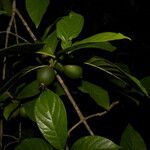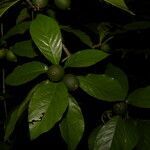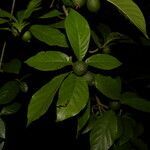Trees to 10 m tall, the branchlets terete or angular, usually opposite, stiff and spreading, subequal, armed terminally or subterminally, the spines 2-4, to 1.8 cm long, thin or relatively stout. Leaves oblong, obovate oblong or oblong rotund, 3-17(-30) cm long, 4.2-5.0(-13.0) cm wide, tapering obtusely at the apex, the acumen to 2 cm long, usually vaguely falcate, acute, obtuse and slightly inequi-lateral at base, the costa prominulous, plane or immersed above, prominent be-neath, the lateral veins (5-)6-8(-10), at first strict, then arcuate, the smaller veins perpendicular, irregularly spreading, chartaceous to papyraceous, concolorous, glabrous above, minutely puberulent on the costa and the veins beneath, occa-sionally barbate in axils or occasionally hairs restricted to the costa. Flowers terminal, solitary, 3.0-3.8 cm long, the hypanthium oblong, ca. 1.5 mm long, the calycine cup ca. 1.5 mm long, petaloid, glabrous and eglandular within, glabrate outside, the calycine teeth 5-6, oblong lanceolate, 4-5 mm long, 2.0-2.2 mm wide, subequal, acute, glabrous except minutely puberulent marginally; corolla white or yellowish, the tube narrow-cylindrical, ca. 25 mm long, ca. 3.5 mm wide in middle, glabrous inside and out, the lobes 5, imbricate, oblong, ca. 5 mm long, obtuse, glabrous; stamens 5, oblong, ca. 5 mm long, ca. 1.8 mm wide, obtuse, versatile, the filaments short, attached near the mouth; stigmas 2, erect, ca. 3 mm long, ca. 2 mm wide, the style linear, as long as the corolla tube, ca. 0.4 mm wide in the middle. Fruits rotund to compressed rotund, 2.3-5.0 cm long, smooth, usually delicately ribbed, glabrous, often minutely lenticellate, the persistent ca-lyx tubular, to 1 cm long.
More
A shrub. It can be climbing. It grows 5 m high. It can be a tree to 11 m high. The bark is reddish-brown but becomes grey. The flowering shoots are short. They have 1-2 pairs of sharp thorns. The male flowers are in bundles and the female flowers occur singly. The stalks have soft grey hairs. The fruit is a round berry. It is 2-3 cm across. The fruit are green but turn orange-yellow. The pulp is edible. They have some hairs. The seeds are in 2 rows. They are flattened and black.




